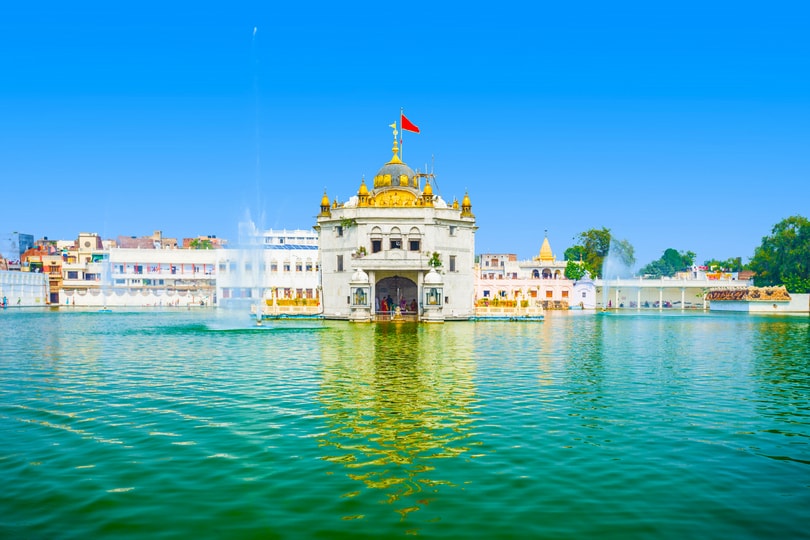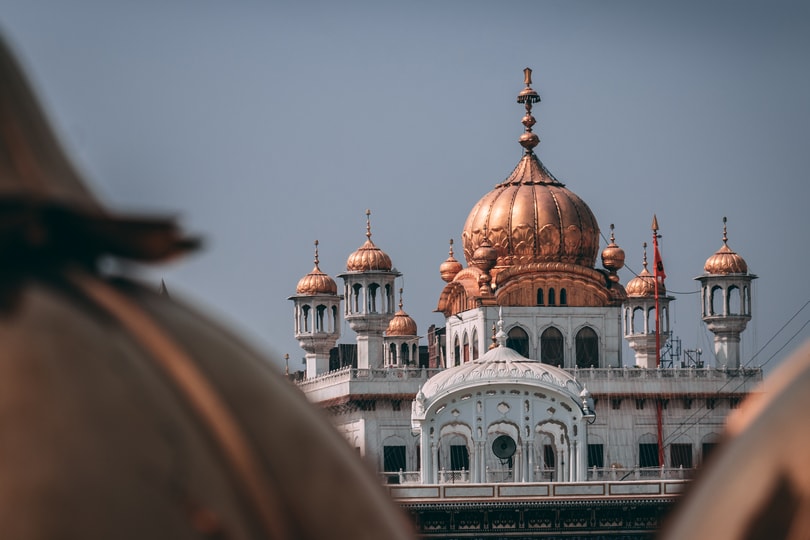Known to be the spiritual and cultural centre of the Sikhs, Amritsar is an iconic city in the Indian state of Punjab. It gloriously portrays the well famed and heroic character of Punjab. Steeped in culture and religion, it is home to Sikhism’s holiest shrine – The Golden Temple.
This city has left its indelible prints in the golden pages of Indian history as well as it is the ground where the Jallianwala Bagh massacre took place. Also, it is geographically situated with close proximity to the Wagah Border, which is the only road border between India and Pakistan. This site is enough to evoke patriotism and love for your mother nation. While the former takes you back in time to India’s struggle for freedom, the latter displays its present-day relationship with its neighbour.
In spite of that, it has thrived through thick times and emerged victoriously. Now it claims to be one of the most visited hot-spots for tourists. This is due to the presence of a multitude of religious sites and tourist spots, it is now a prominent devout destination in the country. The lip-smacking delicacies and generous scoops of legendary Punjabi hospitality further casts an exceptional spell upon the visitors. Temples that date back to the times before the Christ Era to the ones from the Medieval Period, the temples in Amritsar have a story to tell and a sight to behold. Thronged by masses of pilgrims and devotees on a regular basis, Amritsar experiences a heavy rush during the festive seasons.
If you do not believe the hearsay, then go ahead and pay a visit to this charming city. You will be enchanted with its charm and vivaciousness.
Accounted to be one of the most spiritual places in India, Golden Temple, is considered the holiest shrine for Sikhs. It is also referred to as Sri Harmandir Sahib and is alive with religious fervour and sacredness. After a tumultuous period of demolitions, it was again rebuilt by Maharaja Ranjit Singh, from pure marble and gold. The prime focus in the premises is the tank, the Amrit Sarovar, which surrounds the glistening central shrine. The name Amritsar is derived from this Amrit Sarovar, which was excavated by the fourth Sikh guru, Guru Ram Das in 1577. Since it enjoys a strategic position of being right in the heart of Amritsar, it is easily accessible from any part of the city.
In spite of the thousands of people milling about in the premises of the temple, the only voice you will hear around you is silence interspersed with chants of the Sikh prayers. Golden Temple is indisputably one of the most exquisite attractions in the world, its divinity can only be felt and not described.

Shri Durgiana Temple is also called as the Lakshmi Narayan Temple. It accounts to be the next most pious shrine in Amritsar after The Golden Temple. It is in fact much similar to the Golden Temple in its construction and appearance. The chief deity in the temple is Goddess Durga, nonetheless, it is dedicated to Lord Vishnu and Goddess Laksmi as well.
The temple is located in the middle of a water body and one can also find a ghat where pilgrims can take a dip in. It is believed that dipping in these holy waters would erase all the sins from your previous births. The architecture of the temple boasts of exquisite build featuring enormous silver doors and marble walls. It was basically constructed in the turn of the 16-century, however, due to improper maintenance, it turned into shambles. Again in the year 1921, it was renovated by Guru Harsai Mal Kapoor and now stands affirm as you see it today.
The temple provides daily langar (free supper) for devotees and visitors. The main festivals that are celebrated here with great enthusiasm are Dussehra, Janmashtami, Ram Navami, and Diwali.
Lying on the banks of River Ravi, it is basically a cave temple. It has been carved out of a single hill and is found at the base of the hill. Dedicated to Lord Shiva, the temple is also enshrined by the idols of Lord Ganesha, Lord Brahma, Lord Vishnu, Lord Hanuman, and Goddess Parvati.
According to legend, it is said that the Pandavas used to spend some of their time at this time while they were away in exile. Since then it has been revered by hundreds of worshippers who regularly visit this holy shrine to seek blessings. The serenity and calmness that the temple offers adds to the sacred atmosphere.
Some of the important festivals that are celebrated around the year are Chaitya Chodiya in the months of February and March, Navrathri that runs for nine days in the month of October and Mukesran Da Mela. This is actually fair, which marks the arrival of renowned Baisakhi, which is one of the most vital festivals in the state of Punjab. Plan to visit this temple before evening hours and you are in luck if you are here on a Monday. As on Monday’s a special aarti is conducted exclusively for the worship of Lord Shiva.

Akal Takht literally translates to the ‘Throne of the Immortal’, in which ‘Akal’ refers to the Timeless One and ‘Takht’ means the throne. It is regarded as a vital seat in Sikhism with immense significance given to religious and political history. It is situated just opposite the Golden Temple and is planned in a constructive manner with a height slightly lower to the temple that shows the order of importance. Several edicts and preaching based on the principles of Sikhism are announced from here. It is basically a precious symbol of political sovereignty and justice, where the spiritual and earthly concerns of the Sikh people can be addressed and followed-up.
It accounts to be one of the five takhts or seats of power of the Sikh religion. Constructed by the sixth Sikh Guru, Guru Hargobind and is situated within the Harmandir Sahib Gurdwara Complex. The existing structure is a five storey building, laid with immaculate white marble and gold-leafed dome. It is presently located in the Harmandir Sahib Complex, this building faces the Darshini Deorhi, which leads to the Golden Temple.
Of all the five takhts established by the panth (community), Akal Takht is supposedly the supreme. Then after, it is followed by Keshgarh Sahib, Patna Sahib, Hazur Sahib and lastly Damdama Sahib. The original structure of Akal Takht was built by Guru Hargobind Sahib, Bhai Gurdas Ji, and Baba Budha Ji. It also serves as the central altar for the Sikh Political Assembly.
History states that Guru Hargobind Ji used to sit on this raised platform with all marks of royalty and from here dispensed justice for all the disputes that occurred in the Sikh community. One can see the two tall flags in the inner courtyard even today which symbolizes the two swords of Guru Hargobind. This represents his spiritual authority (Piri) and earthly power (Miri). It is also said that the elevated platform inside stands as a symbol of rebellion against Emperor Jehangir, who had a given rule that only an Emperor can sit on a raised platform.
The elegance and charm of this temple have been compared to the famous Piazza Saint Marco in Venice.
Mata Lal Devi Temple is popularly known as Sheesh Mahal or Mirror Mahal of Amritsar. It is hugely famous for its miraculous fertility-improving powers amongst the Hindu pilgrims. Women from across the country visit this mystic temple in order to seek blessings to bear a child, as this temple is famed for having mysterious abilities to uplift the rate of fertility among women.
The temple is dedicated to the female saint Lal Devi and is considered a miniature version of the popular Vaishno Devi Temple in Jammu and Kashmir. The temple is entirely decorated with shimmering mirror works that enlighten the space through the reflecting sunlight and numerous hand-made lamps.
The idols of many other deities are placed on the inner courtyard of the complex. As you walk through the temple, you will see many artefacts, idols, statues, and paintings that throw light upon the life history of Saint Lal Devi.
The temple has carnival-like, bright coloured deities and stairways leading to narrow watery caves. Even the doors are shaped like a large snake and lion heads. This temple is a major attraction for foreign tourists. Even visitors without a religious inclination find this temple quirky due to its magical capabilities.
Best known as the tallest tower in the city of Amritsar, it is a 33-metre high octagonal tower, which is located towards the south-eastern side of the Golden Temple. This religious site was built between the year 1778 and 1784, representing the nine years of Baba Atal’s life. He was the son of Guru Hargobind Sahib, who is the sixth Sikh Guru and had his Samadhi in this place.
As per the legends, when Baba Atal Rai was nine years old, he restored his friend to life after his sudden death. Guru Hargobind Sahib rebuked him for performing the unnatural act and warned him that the spiritual power should be displayed ‘in the purity of doctrine and holiness of living’. Realizing the truth behind his father’s saying, Atal Rai went into a meditative trance and soon demised. This nine-storey building was constructed to commemorate his memory. This floor also offers a birds-eye view of the bustling town of Amritsar to the visitors.
The age-old belief among the devotees is that having a dip in the holy water of Kaulsar Sarovar brings mysterious wide-spread showers in Amritsar. Interestingly, the langar at the Gurudwara serves the visitors 24 hours a day and is said to be the only continuous langar in Amritsar. This religious site is not just a symbol of glory and artistic richness, but it also stands as a memorable reminder of the divine power of Baba Atal Rai.
Next on the list is the sanctified shrine of Mata Kaulan. It is also called as the Gurudwara Mata Kaulan and is located on the west side of the Golden Temple in Amritsar. It has a deep backdrop attached to it. This temple was named after Bibi Kaulan, who was a holy lady born as a Muslim girl but who adopted Hinduism later in her life, becoming a faithful disciple of Guru Har Gobind. As she chose the path of religion, her father disowned her and pronounced her dead for her devotion towards Guru Hargobind Ji. She left her home and stayed abandoned. A saint named Sant Mian Mir, a resident of the same village, secretly brought her to Amritsar, where she spent the rest of her life devoted to Guru Har Gobind while performing religious duties. She was later laid to rest in the western area of Gurudwara Kaulan.
Her melodious Kirtans, which she used to sing every evening, are still chanted and remembered by the older members of the Sikh community. The extraordinary service and devotion that she served to the Gurudwara are often praised in the temple complex. Kaulsar Sarovar, a tank dedicated to her was the first tank in Amritsar to be named after a Muslim woman, is the perfect spot for tourists to feel a sense of serenity and indulge in some introspection and meditation. The sacred tanks close to the Gurudwaras are also considered equally religious. It is one of the most sought after places of worship.
Bibekar Sahib, Jubbi Tree, Harmandir Sahib, and Guru ka Mahal are also a few more religious attractions to the unending list of religious sites in Amritsar. When you are in the spiritual city of Amritsar, do try visiting some or all of these temples. Apart from this, do have the delicious Amritsari Lassi, which is truly a summer treat and a must-try beverage in the city. So why the wait? Plan now and let Amritsar welcome you with open arms.
Happy Journey!

Please go back to portrait mode for the best experience